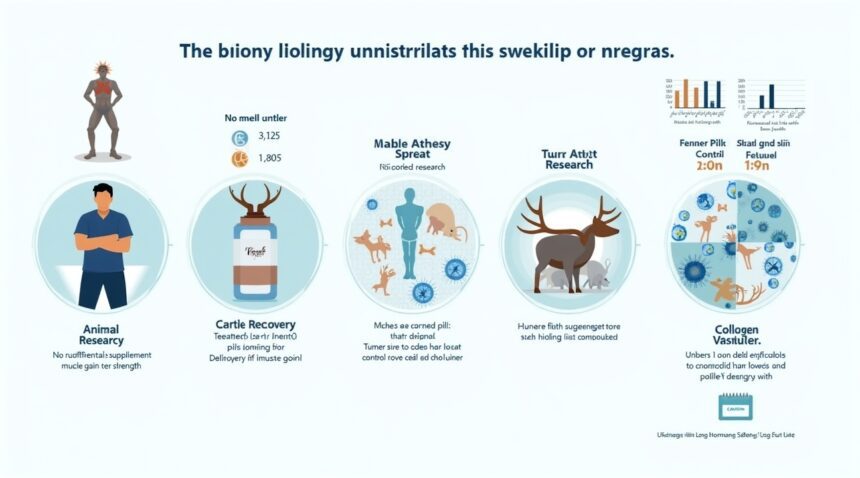Deer antler spray attracts global interest for its diverse health applications, from boosting athletic performance to supporting traditional sexual health remedies.
Understanding the Scientific Landscape of Deer Antler Spray
While deer antler spray is popular in sports and wellness communities, scientific support for many of its claims remains limited or inconclusive. The disparities in findings across different fields make it important to evaluate each potential benefit separately.
Athletic Performance Insights
Controlled scientific trials consistently reveal no significant enhancement in athletic abilities. Most studies demonstrate that those using deer antler spray experience strength and endurance gains similar to those in placebo groups.
Bone and Joint Health Potential
- Animal studies show encouraging effects related to cartilage and joint health, likely due to chondroitin and related compounds in the spray.
- However, human clinical trials are sparse and inconclusive, requiring further investigation.
Early Cancer Research Insights
- Mouse model research suggests anti-cancer potential, including tumor suppression in breast and colon cancers.
- There is no clinical evidence in humans to validate these effects yet, signifying the need for substantial further research.
Sexual Health and Hormonal Support Claims
Despite its historical and cultural heritage in traditional medicine, scientific studies fail to confirm deer antler spray’s effectiveness in supporting sexual health or hormonal balance. Most data are anecdotal or based on traditions, not rigorous science.
Safety Profile Summary
- Generally safe for short-term use in healthy individuals.
- Unknown long-term outcomes and potential interactions with medications or conditions underscore the need for caution.
Key Takeaways
- Scientific studies reflect no consistent benefit for muscle growth or athletic performance.
- Animal-based research implies potential for joint and cartilage support, though human trials are lacking.
- Preliminary cancer studies in animals indicate possible tumor-reducing effects, but can’t be applied to humans yet.
- Historical claims around libido and hormone balance lack credible scientific support.
- Safety appears acceptable in the short term, but users should approach long-term supplementation with caution.
What Science Actually Says About Athletic Performance Claims
I’ve examined the scientific literature on deer antler spray’s athletic performance claims, and the results tell a different story than the marketing suggests. Companies promote these supplements heavily, positioning IGF-1 (Insulin-like Growth Factor 1) as a breakthrough compound for muscle growth and repair. The actual research paints a much more modest picture.
Controlled Studies Reveal Limited Benefits
Double-blind studies consistently show no statistically significant improvement in muscle size, strength, or soreness when comparing deer antler velvet supplementation to placebo groups. This is particularly telling because these studies used resistance-trained men as subjects — exactly the demographic most likely to benefit from legitimate performance enhancers.
A comprehensive 10-week trial provides even more specific data about strength gains. Researchers documented equivalent results across both the velvet supplement and placebo groups, with all participants achieving a 41% increase in 6RM strength regardless of which treatment they received. This finding suggests that any perceived benefits likely stem from the training protocol itself rather than the supplement.
Endurance and Recovery Claims Fall Short
The endurance claims surrounding deer antler spray face similar scrutiny in controlled settings. Resistance-trained human subjects didn’t demonstrate enhanced fatigue resistance or improved endurance compared to those taking placebo supplements. Marketing materials often highlight individual testimonials and anecdotal reports, but these controlled studies strip away the psychological factors that can influence perceived performance.
IGF-1 remains the primary selling point for these products, yet the research indicates that oral supplementation doesn’t translate into the muscle-building benefits that companies claim. The compound’s bioavailability through oral administration presents significant challenges that manufacturers rarely address in their promotional materials. Athletes seeking genuine performance improvements might find better results focusing on proven training methods and established nutritional strategies.
The disconnect between marketing claims and scientific evidence becomes particularly apparent when examining muscle recovery metrics. Studies measuring post-exercise soreness and recovery time show no meaningful differences between deer antler spray users and control groups. These findings matter because recovery represents one of the most commonly cited reasons athletes consider supplementation in the first place.
Promising Animal Research on Bone and Joint Health
Animal studies reveal fascinating insights into deer antler velvet’s potential for supporting bone and joint health. Laboratory research consistently demonstrates that this supplement may promote bone growth and assist in cartilage repair processes. These findings have sparked considerable interest among researchers studying natural approaches to musculoskeletal health.
Key Components and Mechanisms
Deer antler velvet contains chondroitin, a major component of cartilage that researchers have linked to potential pain relief for osteoarthritis sufferers. This naturally occurring compound plays a crucial role in maintaining cartilage structure and function. Animal models show promise when testing velvet supplementation for various bone-related conditions.
One notable animal study documented increased femoral bone length and elevated bone enzyme levels following velvet supplementation. These biochemical markers suggest enhanced bone formation activity, which could translate to stronger skeletal structures over time. The research indicates that specific compounds within deer antler velvet may stimulate cellular processes responsible for bone development.
Clinical Evidence Limitations
Despite encouraging animal research, human studies present a different picture. Randomized controlled trials examining joint health benefits in people remain limited and inconclusive. The gap between laboratory findings and human applications represents a significant challenge for researchers.
Current evidence suggests that while deer antler velvet shows promise in controlled animal environments, translating these benefits to human subjects requires more comprehensive clinical investigation. Several factors may explain this discrepancy, including:
- Dosage differences
- Bioavailability variations
- The complexity of human physiology compared to animal models
Test-tube studies complement animal research by demonstrating cellular-level interactions. These controlled environments allow scientists to observe how deer antler velvet compounds affect bone and cartilage cells directly. However, laboratory conditions don’t fully replicate the complex biological systems found in living organisms.
Joint health enthusiasts often look to natural supplements for support, much like how gamers seek comprehensive guides for challenging activities. The preliminary research on deer antler velvet provides a foundation for understanding its potential mechanisms, though human applications require further validation.
Researchers continue investigating optimal dosages, delivery methods, and potential synergistic effects with other compounds. The chondroitin content alone makes deer antler velvet an interesting subject for osteoarthritis research, given this compound’s established role in cartilage health. Future studies may help bridge the gap between promising animal research and practical human applications for bone and joint support.

Early Cancer Research Shows Tumor Suppression in Animal Models
Researchers have discovered promising anti-cancer properties in deer antler velvet extract through controlled laboratory studies. Multiple in vivo mouse studies revealed that deer antler velvet extract successfully suppressed tumor growth, with particularly strong results in breast cancer and colon cancer models.
Scientists believe the anti-cancer effects stem from tumor suppressor proteins naturally present in deer antler velvet. These bioactive compounds play a crucial role in the antler regeneration process, which involves rapid cell growth and tissue formation. The same mechanisms that allow deer to regrow entire antlers annually may hold the key to understanding how these extracts combat cancerous growths.
Research Findings and Mechanisms
The animal studies showed several encouraging outcomes that warrant further investigation:
- Reduced tumor size in treated mice compared to control groups
- Decreased severity of existing tumors in animals receiving deer antler extract
- Slower progression of cancerous growths across multiple cancer types
- Enhanced expression of natural tumor suppressor proteins
The bioactive factors found in deer antler velvet appear to trigger the body’s own defense mechanisms against cancer cells. This differs from traditional chemotherapy approaches that directly attack tumors. Instead, the extract seems to strengthen the immune system’s ability to recognize and eliminate abnormal cell growth.
I find the breast cancer and colon cancer results particularly noteworthy because these represent two of the most common cancer types affecting humans. The consistent tumor suppression across different cancer models suggests the extract’s anti-cancer properties may not be limited to specific cancer types.
However, I must emphasize that no high-quality clinical data exists regarding anti-cancer effects in humans. The research remains in early stages, confined to laboratory animal models. While scientific breakthroughs often begin with promising animal studies, translating these results to human applications requires extensive clinical trials.
The tumor suppressor proteins identified in deer antler velvet extract mirror those found naturally in healthy human cells. This biological similarity offers hope that the anti-cancer mechanisms observed in mice might eventually prove effective in human patients. Research teams continue investigating which specific bioactive compounds provide the strongest tumor suppression effects.
Current evidence suggests that deer antler velvet’s regenerative properties may offer a novel approach to cancer treatment. The extract’s ability to promote healthy tissue growth while simultaneously suppressing tumor development presents an intriguing therapeutic possibility that deserves continued scientific exploration.
Traditional Uses for Sexual Health and Hormonal Support
I’ve observed deer antler spray gain considerable attention among men seeking natural alternatives for sexual health and hormonal support. Traditional practitioners have long promoted this supplement for enhancing sexual function and fertility, positioning it as a natural remedy for various reproductive concerns.
Testosterone and Hormonal Balance Claims
Proponents suggest deer antler spray can potentially raise testosterone levels and address late-onset hypogonadism, a condition affecting older men with declining hormone production. The theory centers around the supplement’s potential to modulate testosterone through IGF-1 (insulin-like growth factor-1) pathways. However, I must emphasize that controlled studies examining these effects remain scarce, and the available evidence presents inconsistencies that make definitive conclusions challenging.
The mechanism behind these purported benefits involves complex hormonal interactions. Some researchers theorize that compounds within deer antler velvet might influence the body’s natural testosterone production or enhance the effectiveness of existing hormones. Despite these theories, the scientific community hasn’t established concrete proof supporting these claims through rigorous clinical trials.
Physical Performance and Anti-Fatigue Properties
Beyond sexual health applications, deer antler spray has attracted attention from athletes and fitness enthusiasts. Mouse studies have demonstrated some intriguing findings regarding antler velvet supplementation’s impact on physical performance. Research indicates that mice receiving antler velvet supplements showed reduced fatigue levels and increased swimming speed compared to control groups.
Scientists attribute these performance benefits to nucleosides present in deer antler velvet. These compounds may play a role in:
- Enhancing cellular energy production
- Supporting recovery after physical exertion
- Improving endurance capacity during exercise
- Reducing markers of fatigue at the cellular level
I find it important to note that while these animal studies provide interesting insights, translating results from mouse models to human applications requires significant caution. The biological differences between species mean that effects observed in laboratory animals don’t automatically apply to humans.
The connection between physical performance enhancement and sexual health isn’t coincidental. Many traditional medicine systems view these aspects as interconnected, suggesting that improvements in overall vitality and energy can translate to better sexual function. This holistic approach explains why deer antler spray appears in discussions about both athletic performance and reproductive health.
Current research gaps present significant challenges for anyone considering deer antler spray for hormonal support. While traditional use spans centuries, modern scientific validation remains limited. The supplement industry has embraced these traditional claims, but consumers should understand that anecdotal evidence and historical use don’t substitute for controlled clinical trials.
I encourage individuals interested in deer antler spray for sexual health or hormonal concerns to approach the topic with realistic expectations. The lack of substantial human studies means that potential benefits remain largely theoretical. Anyone experiencing symptoms of low testosterone or sexual dysfunction should consult healthcare providers who can offer evidence-based treatments and proper diagnostic testing.
The supplement’s popularity continues growing despite limited scientific backing, partly due to its natural origin and traditional pedigree. Many users report positive experiences, though distinguishing between genuine physiological effects and placebo responses proves difficult without controlled studies. This situation mirrors challenges faced by many traditional remedies seeking validation through modern scientific methods.
Understanding these limitations helps consumers make informed decisions about incorporating deer antler spray into their health routines. While the supplement may offer benefits for some individuals, I recommend viewing it as a complementary approach rather than a primary treatment for serious hormonal imbalances or sexual health issues.
Emerging Research on Hair Growth and Skin Benefits
Early research into deer antler velvet reveals promising applications beyond traditional athletic performance enhancement. Scientists have identified bioactive compounds within antler velvet that may contribute to hair follicle stimulation and skin regeneration processes.
Cellular Regeneration Mechanisms
The mechanism behind these potential benefits centers on cellular activity stimulation. Growth factors and peptides naturally present in antler velvet appear to encourage cell proliferation at the follicular level. These compounds work by potentially activating dormant hair follicles and supporting the natural hair growth cycle.
Initial studies conducted on mouse models and human cell cultures suggest that antler velvet extracts can stimulate cellular regeneration processes. The bioactive peptides found in deer antler may promote increased blood circulation to hair follicles, which supports nutrient delivery and waste removal. This enhanced circulation could create an optimal environment for healthy hair development.
Research on skin health benefits follows similar pathways. The same growth factors that may influence hair follicle activity also appear to support skin cell regeneration. Test-tube studies indicate that certain compounds in antler velvet can accelerate the skin’s natural repair mechanisms, potentially leading to improved texture and appearance.
The peptide content in deer antler spray specifically targets cellular communication pathways involved in tissue repair. These molecules may signal skin cells to increase collagen production, which supports skin elasticity and structure. Enhanced collagen synthesis could contribute to reduced appearance of fine lines and improved skin firmness.
Scientists have observed that antler velvet’s growth factor profile closely resembles compounds naturally produced by the human body during youth. This similarity suggests why these substances might effectively support hair and skin health as we age. The body’s natural production of these beneficial compounds typically decreases over time, making supplementation potentially valuable.
Current research focuses on identifying the most active components within antler velvet extracts. Researchers are particularly interested in:
- Insulin-like growth factor-1 (IGF-1)
- Various amino acid sequences with regenerative properties
While these early findings show promise, most studies remain in preliminary phases. The transition from laboratory results to real-world applications requires extensive human trials to confirm safety and effectiveness. However, the biological mechanisms identified provide a scientific foundation for understanding how deer antler spray might support hair growth and skin health.
The concentration and bioavailability of active compounds in commercial deer antler sprays varies significantly between products. This variation affects the potential for achieving the beneficial effects observed in controlled laboratory environments.

Safety Profile and What We Don’t Know
I find that most research on deer antler spray reveals a relatively favorable short-term safety profile for healthy adults. Clinical studies typically report minimal adverse effects when participants use these supplements for brief periods under controlled conditions. Common side effects, when they do occur, tend to be mild and include digestive discomfort, headaches, or temporary changes in sleep patterns.
Short-Term Safety Evidence
The available data suggests that healthy individuals can generally tolerate deer antler spray without significant complications during short-term use. Research participants in controlled studies rarely experience serious adverse reactions, though individual responses can vary considerably. I should note that most safety assessments focus on periods ranging from a few weeks to several months, leaving substantial gaps in our understanding of extended use.
Critical Knowledge Gaps
Long-term safety remains one of the most significant unknowns surrounding deer antler spray supplementation. I can’t provide definitive guidance on what happens when people use these products for years because comprehensive studies simply don’t exist. The following areas represent major gaps in our current knowledge:
- Potential interactions with prescription medications, particularly those affecting hormone levels or blood clotting
- Effects on individuals with pre-existing health conditions such as diabetes, cardiovascular disease, or autoimmune disorders
- Impact on hormone-sensitive conditions including certain cancers or reproductive health issues
- Safety during pregnancy, breastfeeding, or in children and adolescents
- Long-term effects on liver and kidney function with chronic use
I must emphasize that the supplement industry operates with less stringent oversight than pharmaceutical medications. Manufacturers aren’t required to conduct extensive safety trials before bringing deer antler spray products to market. This regulatory environment means consumers often become unwitting participants in long-term safety experiments.
The lack of standardization across products compounds these safety concerns. Different manufacturers use varying extraction methods, concentrations, and additional ingredients, making it difficult to predict how any specific product might affect an individual. Some products may contain undisclosed compounds or contaminants that could pose additional risks.
Athletes should exercise particular caution, as certain deer antler spray formulations might contain substances banned by sports organizations. The World Anti-Doping Agency has expressed concerns about IGF-1 content in these supplements, though detection and enforcement remain inconsistent.
I recommend consulting healthcare providers before starting any deer antler spray regimen, especially for individuals taking medications or managing chronic health conditions. The current evidence simply doesn’t support making broad safety claims about long-term use, and what we don’t know about these supplements significantly outweighs what we do know.
Sources:
Healthline — “What Are Deer Antler Supplements? Health Effects and Safety”
East Tennessee State University — “Examining the Effects of Deer Antler Velvet Supplementation on…” (Thesis/Dissertation)
Nature — “Anti-tumour activity of deer growing antlers and its potential…”
Journal of the New Zealand Medical Association — “Health benefits of deer and elk velvet antler supplements: a systematic review of randomised controlled studies”
University of Nevada, Las Vegas — “Changes in IGF-1 Levels Post Deer Antler Velvet Supplementation” (Thesis/Dissertation)
International Journal of Sport Nutrition and Exercise Metabolism — “The effects of deer antler velvet extract or powder supplementation on aerobic power, erythropoiesis, and muscular strength and endurance characteristics”


